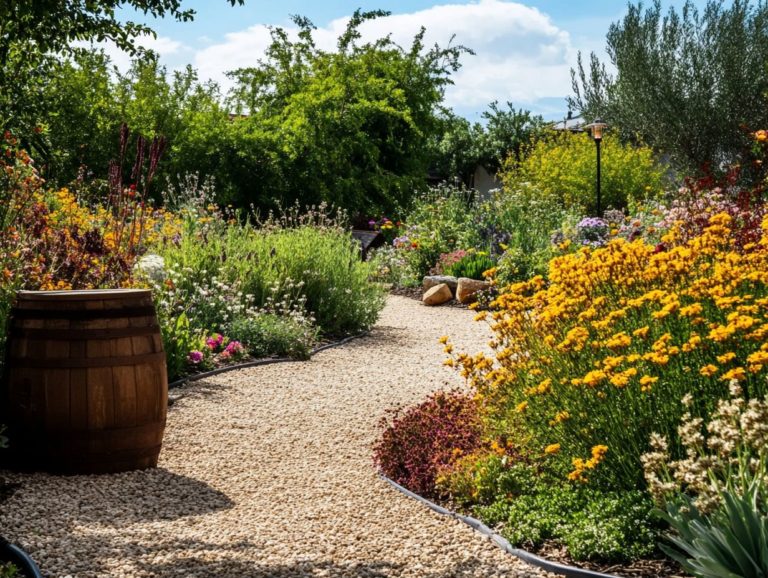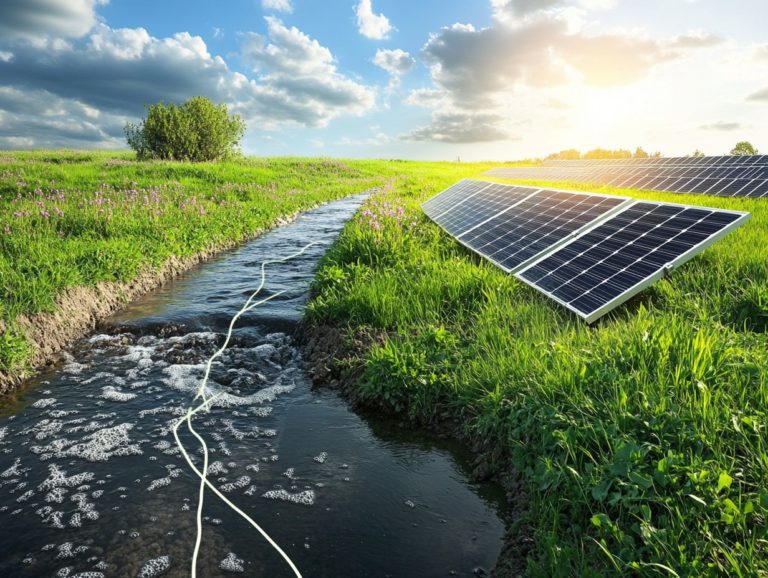The Role of Drought-Tolerant Plants in Conservation
Drought-tolerant plants aren t just a trend in gardening; they re essential players in the realms of conservation and sustainability.
As climate change escalates and water scarcity looms large, understanding the importance of these resilient plants becomes crucial for your landscapes and ecosystems. This article explores their special features, highlights their benefits for biodiversity, and offers practical tips for weaving them into your garden.
You ll also find maintenance techniques to help them thrive while conserving precious water resources.
Join us as we explore how these plants can transform outdoor spaces and pave the way for a greener future!
Contents
- Key Takeaways:
- What Are Drought-Tolerant Plants?
- Importance of Drought-Tolerant Plants in Conservation
- Benefits for Ecosystems and Biodiversity
- Examples of Drought-Tolerant Plants
- How to Incorporate Drought-Tolerant Plants in Landscaping
- Caring for Drought-Tolerant Plants
- Impact of Drought-Tolerant Plants on Water Conservation
- Frequently Asked Questions
- What are drought-tolerant plants and how do they contribute to conservation?
- Why are drought-tolerant plants important in conservation efforts?
- How do drought-tolerant plants help in water conservation?
- What are some examples of drought-tolerant plants?
- How can using drought-tolerant plants in landscaping benefit conservation efforts?
- Are drought-tolerant plants suitable for all regions and climates?
Key Takeaways:
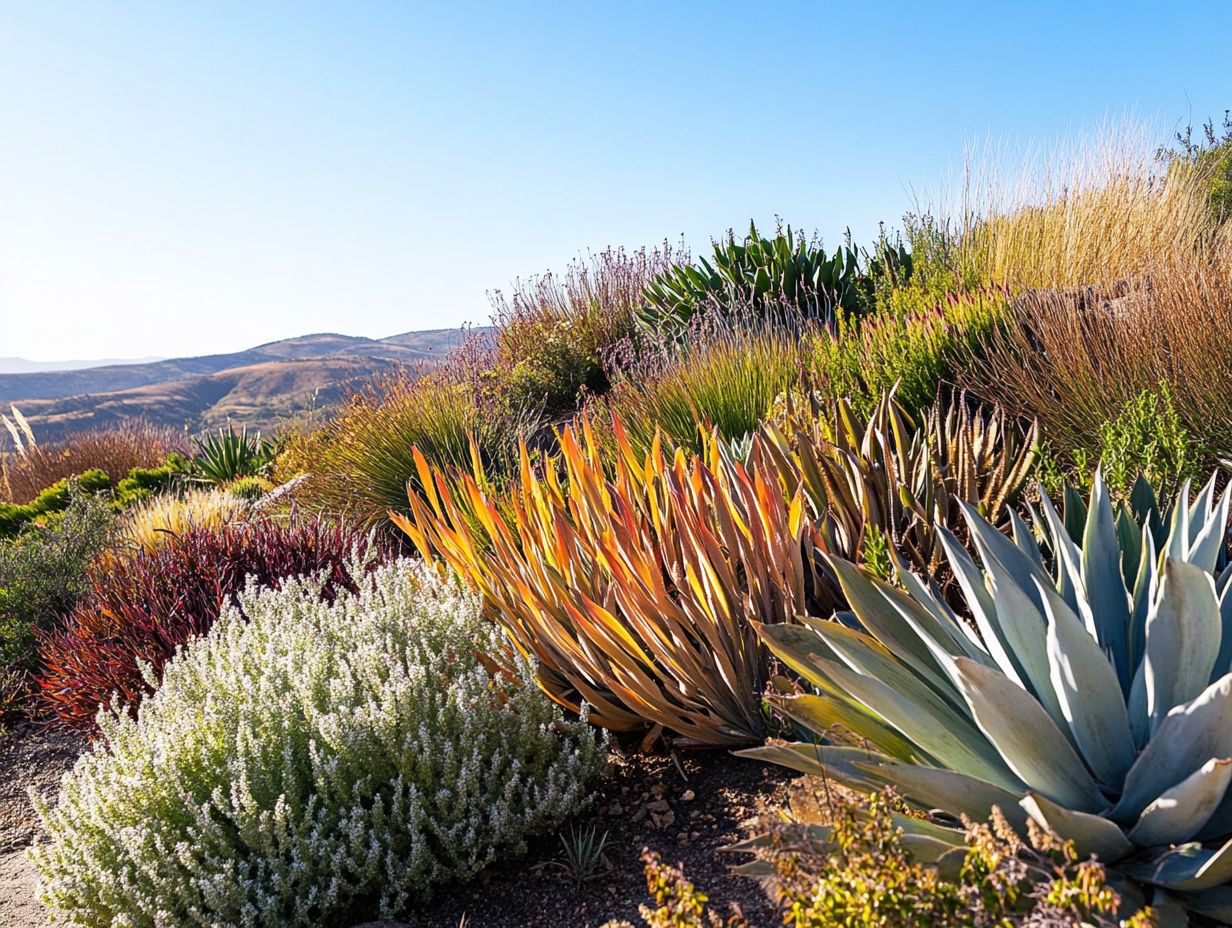
What Are Drought-Tolerant Plants?
Understanding drought-tolerant plants is crucial for you as a gardener or landscaper aiming to create eco-friendly gardens that not only survive but thrive under extreme drought conditions.
These remarkable plants possess special features that allow them to adapt and flourish in arid regions. This makes them a wise choice for water-efficient landscaping and a vital component of a sustainable ecosystem.
Choosing native plants helps support local fauna, minimize reliance on additional water sources, and promote soil moisture retention. This approach leads to a vibrant environment, even in the face of climate change challenges.
Definition and Characteristics
Drought-tolerant plants are remarkable in their ability to flourish under conditions of limited water and dry soil, showcasing a range of adaptations that enhance their resilience. You ll often find these plants equipped with impressive traits, such as deep roots that tap into subterranean moisture, waxy leaves that minimize evaporation, and the capacity to enter a state of dormancy a period when plants temporarily stop growing to conserve water during severe droughts.
Beyond these adaptations, many drought-tolerant species boast specialized leaf structures designed to reduce water loss. Think small or needle-like leaves that cut down on surface area for transpiration.
Take the California poppy and sagebrush, for example; these native plants exemplify such resilience, thriving in arid landscapes while offering essential ecological benefits. Their deep-root systems not only anchor the soil to combat erosion but also create habitats and food sources for local wildlife.
These adaptive features make drought-tolerant plants essential for biodiversity and ecosystem health, particularly in regions grappling with climate change.
Importance of Drought-Tolerant Plants in Conservation
The significance of drought-tolerant plants in conservation is crucial now more than ever, as they are essential for fostering biodiversity and establishing sustainable ecosystems.
These plants are instrumental in mitigating the impacts of climate change, especially in areas grappling with intense water scarcity and prolonged droughts.
By integrating drought-resistant plants into your landscaping, you can greatly enrich plant diversity and actively contribute to vital water conservation efforts, which are crucial for the survival of both wildlife and native flora.
Benefits for Ecosystems and Biodiversity
Drought-resistant plants offer numerous benefits for ecosystems and biodiversity. They help create colorful gardens that attract wildlife and promote sustainable practices.
By embracing these plants, you support local wildlife and create habitats that foster diverse interactions among plants and animals. This diversity is vital for maintaining a healthy environment.
These plants are essential for pollinators like bees and butterflies, which rely on them for food and shelter. For instance, plants such as lavender and coneflowers provide nectar while attracting these important species, boosting overall biodiversity.
Drought-tolerant varieties, including native grasses and desert succulents, improve soil health by reducing erosion and enhancing water retention. Their deep root systems stabilize the soil and prevent runoff, leading to better water quality in nearby streams and rivers.
Integrating these resilient plants into your garden creates a balanced environment that can withstand the challenges of climate change.
Examples of Drought-Tolerant Plants
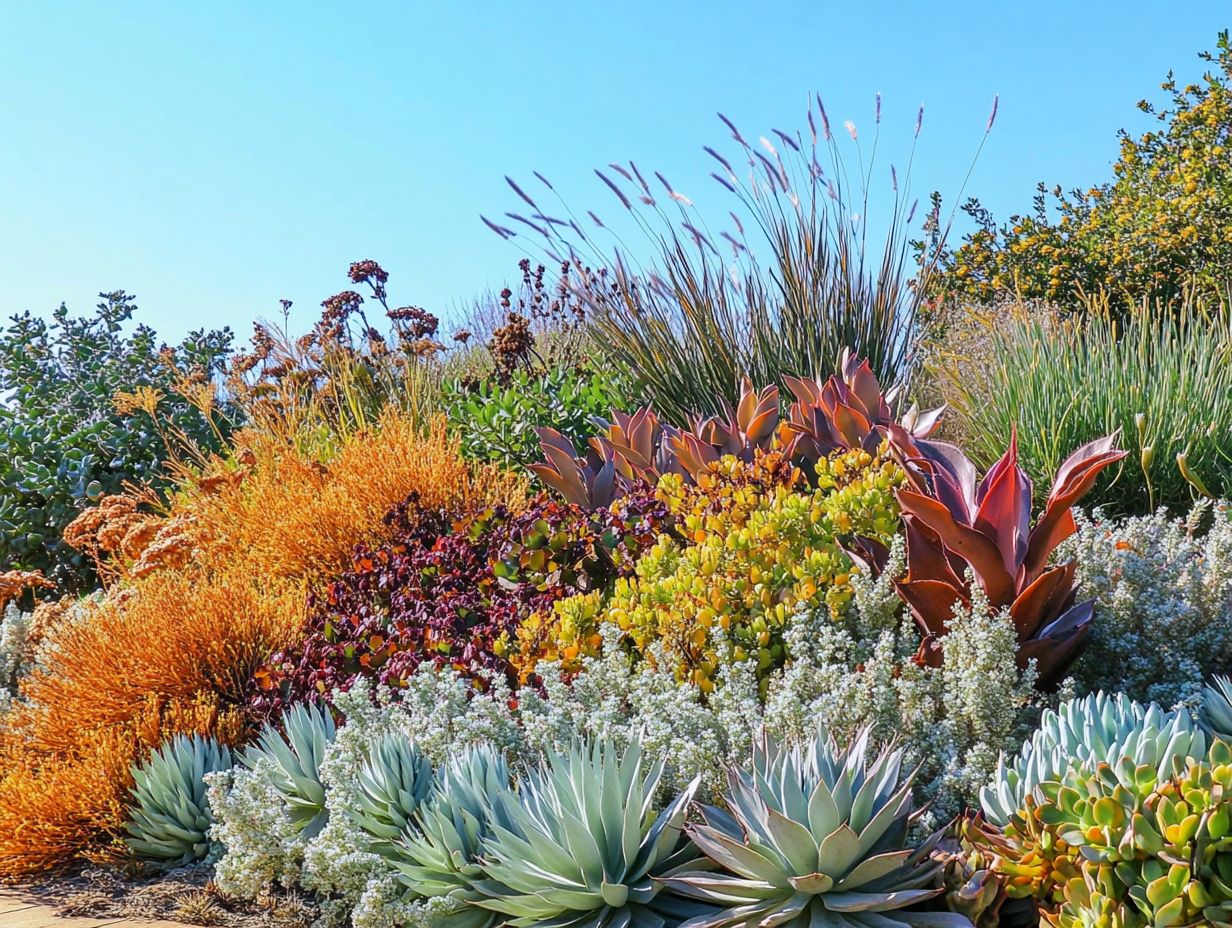
When exploring drought-tolerant plants, it’s important to include both native species and cultivated varieties that thrive in dry conditions. Consider options like:
- Agastache spp.
- Salvia spp.
- Echinacea purpurea
These stunning plants can help you create beautiful, eco-friendly landscapes. Mediterranean herbs are not only resilient but also enhance the garden’s aesthetics and attract beneficial pollinators like butterflies and bees.
Native Species and Cultivated Varieties
Native species and cultivated varieties of drought-tolerant plants offer an excellent selection for creating sustainable landscapes that support local wildlife. Native plants have unique adaptations that help them thrive in specific climates. Cultivated varieties add their own charm with different colors and shapes, all while being drought-resistant.
Choosing native plants enhances local biodiversity as they fit well into the ecosystem, providing crucial habitats and food for local pollinators, birds, and other wildlife.
For example, native grasses like blue grama and wildflowers such as black-eyed Susan thrive in dry conditions and support a variety of insects. Cultivated varieties, like ornamental grasses such as Mexican feather grass, add beauty while attracting beneficial species.
Selecting native species not only maintains ecological balance but also ensures your garden remains a visual delight, resilient against drought challenges.
How to Incorporate Drought-Tolerant Plants in Landscaping
Incorporating drought-tolerant plants into your landscaping requires thoughtful planning and design strategies. Ensure these plants thrive while contributing to a beautiful garden.
To maximize the benefits of these water-efficient species, try using organic mulch to keep your soil moist and group plants with similar water needs. This approach helps create a harmonious space that conserves water and attracts local wildlife, fostering a vibrant ecosystem.
Don t wait transform your garden into a sustainable oasis today!
Design Tips and Best Practices
Implementing effective design strategies is key when integrating drought-tolerant plants into your landscaping. Carefully select plant pairings that enhance diversity and complement local wildlife habitats while minimizing water use.
Consider layering different heights and textures to create visual interest. This will turn your garden into a sustainable yet stunning space. Choose a color palette that fits your surroundings; cool shades evoke tranquility, while warmer tones bring vibrancy.
Keep seasonal interest in mind; incorporating plants that bloom at various times keeps your garden lively throughout the year. Also, pay attention to plant placement to maximize sunlight exposure and consider soil type to ensure they thrive even in less-than-ideal conditions.
Caring for Drought-Tolerant Plants
Caring for drought-tolerant plants requires good knowledge of their unique needs. Implementing effective watering and maintenance techniques ensures their long-term survival and vitality.
Although these resilient plants thrive in dry soil, initial watering and periodic maintenance are crucial. This support fosters deep root growth.
By closely monitoring soil moisture and adjusting care methods to suit specific climate conditions, you can cultivate healthy plants. They not only enhance your garden but also contribute to sustainable ecosystems while conserving precious water resources.
Watering and Maintenance Techniques
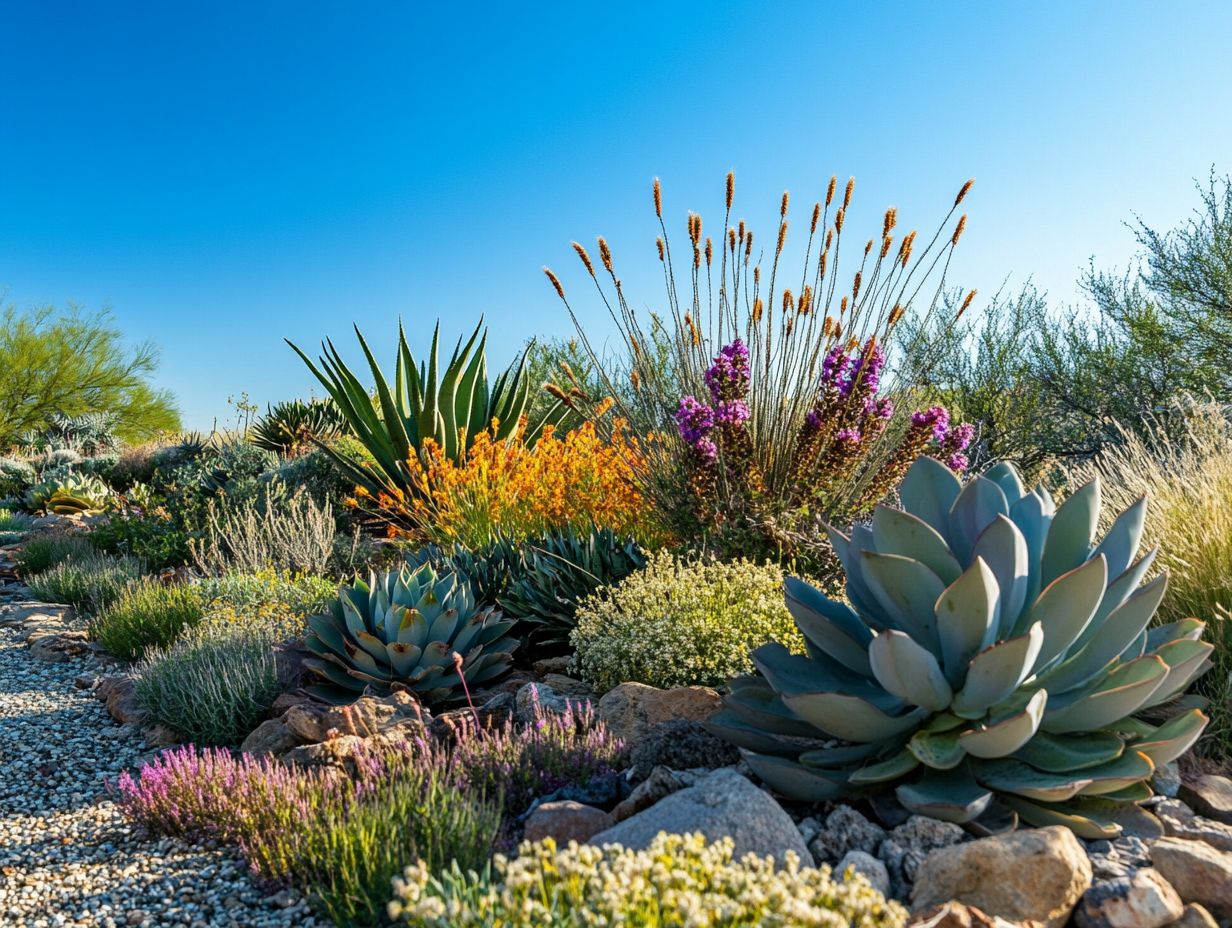
Proper watering and maintenance techniques are essential for establishing drought-tolerant plants in your garden. These practices ensure their longevity.
Understanding the specific watering needs of these plants, especially during their initial growth phase, enhances their resilience and overall health. Methods like deep watering allow moisture to penetrate deeply into the soil, encouraging robust root systems.
Schedule your watering based on weather patterns. This approach conserves water and aligns with the plants requirements, ensuring they thrive even during dry spells.
Incorporating maintenance practices such as mulching helps retain soil moisture. Selective fertilization supports nutrient needs without overwhelming the soil.
Effective pest control strategies are vital. Protecting your plants from harmful insects bolsters their durability and promotes a flourishing garden ecosystem.
Impact of Drought-Tolerant Plants on Water Conservation
The impact of drought-tolerant plants on water conservation is transformative. By integrating these resilient varieties into your landscaping, you significantly reduce water usage.
This reduction lessens your dependence on external water sources. It fosters sustainable practices that positively influence the environment.
Embrace drought-resistant plants now for a thriving garden! They are crucial in today s climate-change landscape, where conventional gardening methods lead to excessive water consumption.
Reducing Water Usage and Promoting Sustainability
Reducing water usage by integrating drought-tolerant plants is essential for promoting sustainability in your gardening practices. These resilient plants flourish in low-water environments and lessen the overall demand on local water sources.
To maximize benefits from these water-wise plants, implement efficient irrigation systems like drip irrigation or soaker hoses. These systems deliver water directly to the roots.
Select the right combinations of plants to create a harmonious ecosystem. Grouping plants with similar water needs helps minimize waste and fosters healthier growth.
These sustainable practices cultivate a flourishing garden. They also contribute to conserving precious water resources, building resilience in the face of changing climate conditions.
Frequently Asked Questions
What are drought-tolerant plants and how do they contribute to conservation?
Drought-tolerant plants are species that survive in areas with limited water resources. They contribute to conservation by reducing the need for water and promoting biodiversity.
Why are drought-tolerant plants important in conservation efforts?
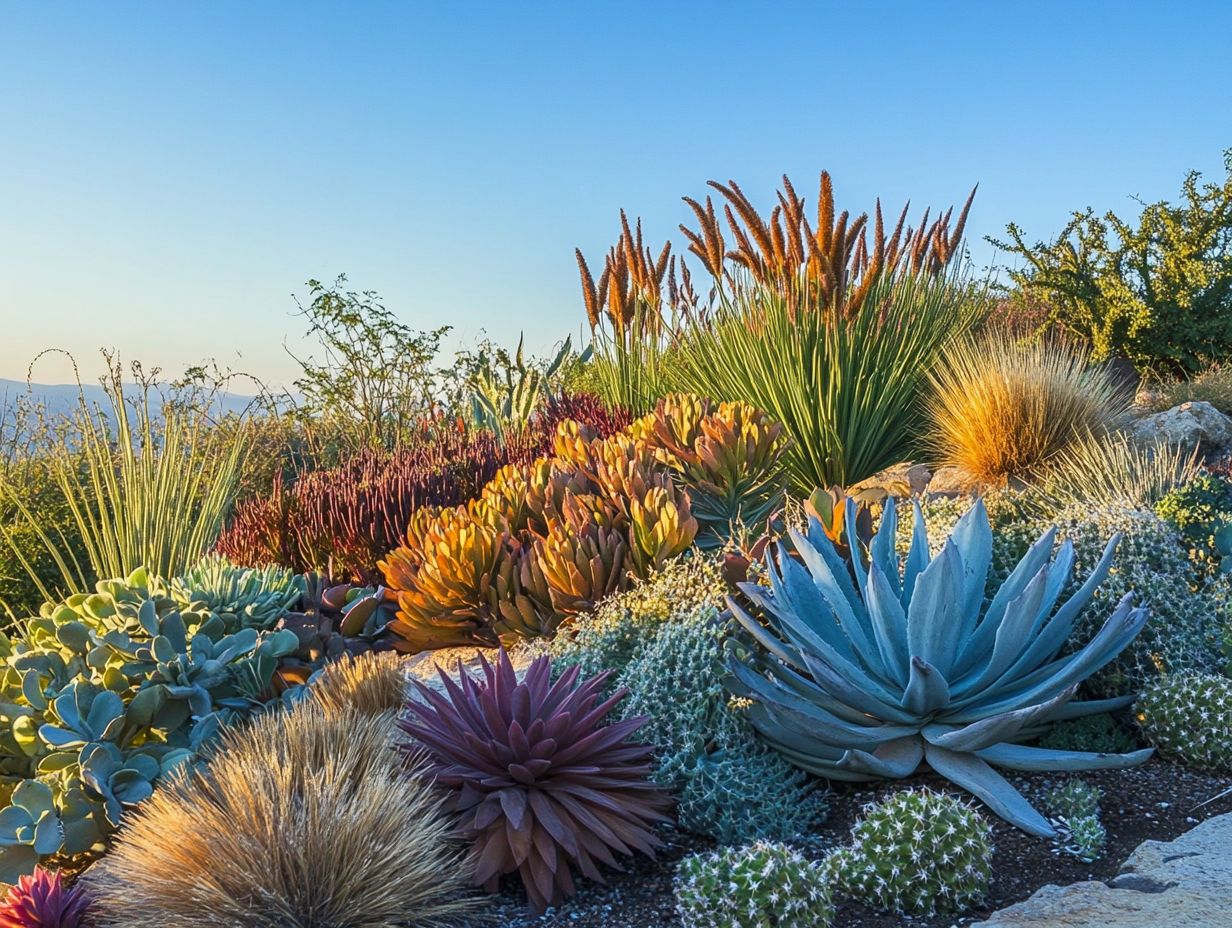
Drought-tolerant plants thrive in dry conditions that are becoming more common due to climate change. They are crucial for maintaining the health and stability of ecosystems.
Start planting today to create your own beautiful, low-water garden!
How do drought-tolerant plants help in water conservation?
Drought-tolerant plants use less water to survive. This is crucial in areas that face drought or water scarcity!
What are some examples of drought-tolerant plants?
Examples include succulents, cacti, lavender, rosemary, and yarrow. These plants can store water in their leaves, stems, or roots, making them perfect for dry conditions!
How can using drought-tolerant plants in landscaping benefit conservation efforts?
Using drought-tolerant plants cuts down the need for irrigation, fertilizers, and pesticides. This approach not only conserves water but also contributes to a healthier environment!
Are drought-tolerant plants suitable for all regions and climates?
Many drought-tolerant plants adapt to various regions, but some thrive only in specific areas. It’s essential to research and choose the right species for your location to maximize their benefits!
Start your own drought-tolerant garden today and contribute to water conservation and sustainability!

